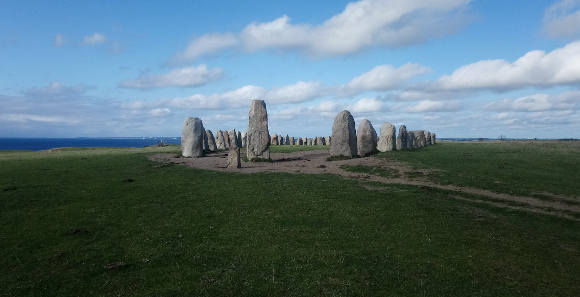I had an occasion to visit this monument recently, so I thought “Hey, we desperately need yet another crazy idea about its significance!”, so here we go…


I had an occasion to visit this monument recently, so I thought “Hey, we desperately need yet another crazy idea about its significance!”, so here we go…

A table which compares the phones of Bornholmsk (Espersen 1908 & Prince 1924) with those in mainland Scanian (from the north-western area according to Lucazin 2010).
| Phoneme | Bh IPA | Scy. IPA | words so pronounced |
| /a/ | [a] | [ɑ] or [a] | land (country/land), kat (cat) |
| /ā/ | [aː] | [aː] or [ɑː] | fara (travel), kar (man/chap) |
| /ɑ̄/ | [ɑʊ]1 | [aʊ̭], [ɑʊ̭] or [ɑː] | dag (day), klar (clear) |
| /e/ | [e] | [ɛ] | fett (fat/grease) |
| /ē/ or /ei/ | [eː] | [eː]2 | ner (down), reza (journey v.) |
| /ai/ | [æi] | [ai] | Scy. fail/Sv. fel (failure/wrong) |
| /ī/ | [iː] | [ei]3 | kniʋ (knife) |
| /i/ | [i] | [i] or [ei̭] | brink (brink), sil (herring) |
| /o/ | no info | [ʊ] or [eʊ̭]4 | ondra (lower), gold (gold) |
| /ō/ | “English oh“ | [eʊ] | sol (sun) |
| /ū/ | [ʉː]?? | [øʉ] | skruʋa (screw) |
| /ȳ/ | [yː] | [øʏ] | sky (sky), myra (ant) |
| /ǣ/ | [əe] | [ai] or [ɛː] | knæ (knee) |
| /ø̄/ | “i in bird“ | [øː]5 | rød (red), bøste (loin/flank/ham) |
| /ɔ̄/ | [eʊ] | — | nål (needle), see ō |
| /b/ | [b] | [b] | bæra (carry), flab (mouth) |
| /d/ | [d] | [d] | dra (drag/pull) |
| /f/ | [f] | [f] | fæ (cattle) |
| /h/ | [h] | [h] | — |
| /j/ | [j] | [ɪ̭] | jord (earth) |
| /l/ | [l] | [l] | luka (weed v.) |
| /m/ | [m] | [m] | — |
| /p/ | [p] | [p] | — |
| /t/ | [t] | [t] | — |
| /g/ and /j/ | [g] and [j] | [g] and [ɪ] | — |
| /z/ | [z] | [s] | snaka (talk) |
| /s/ | [s] | [s] | Bh. sten/Scy. stain (stone) |
| /r/ | [r] | [ʁ] | — |
| /k/ and /ɕ/ | [k], [t͡ɕ] and [ɕ] | [k], [t͡ɕ] and [ɕ] | — |
| /n/, /ɲ/ and /ŋ/ | [n], [ɲ] and [ŋ] | [n] and [ŋ] | springa (chink/slit) |
| /ʋ/ | [ʋ] | [ʋ] | kiʋa (row/quarrel v.) |
1 Since the sources predate IPA, Prince doesn’t mention it and it doesn’t exist in Danish, my sources really don’t say what it sounds like, but [ɑʊ] is likely.
2 [eː] I am pretty confident that this sound isn’t a common realization of /ē/ in NW Scania, since I grew up in NW Scania and I can pronounce it in speech only with very much difficulty. [ei̭] possible.
3 actually [ei̭ː] is the notation in Lucazin p. 27. Certainly, in the NW, the i is pronounced longer than the e.
4 [o] is my guess for both accents.
5 This should probably be a diphthong instead.
Literature used:
Utkast till ortografi över Skånska Språket (2010), M Lucazin.
The Danish Dialect of Bornholm (1924) John Dyneley Prince.
Bornholmsk Ordbog (1908) J C S Espersen & Konglige Danske Videnskabernes Selskab.